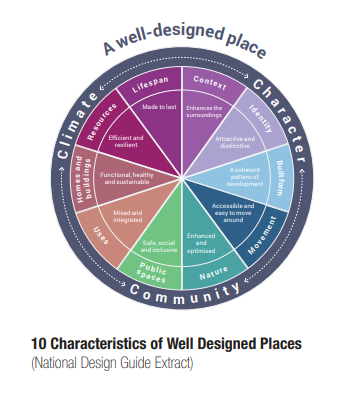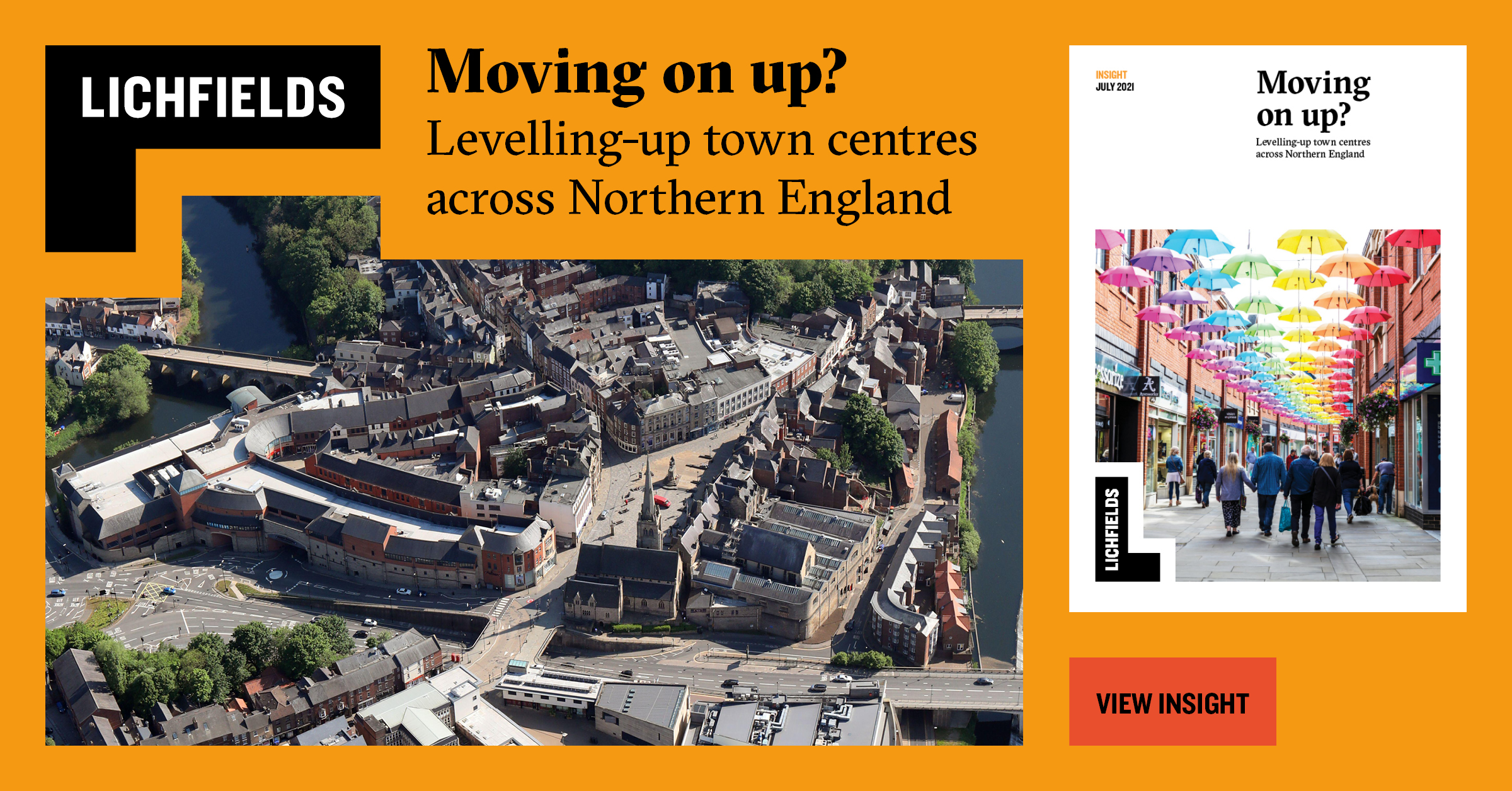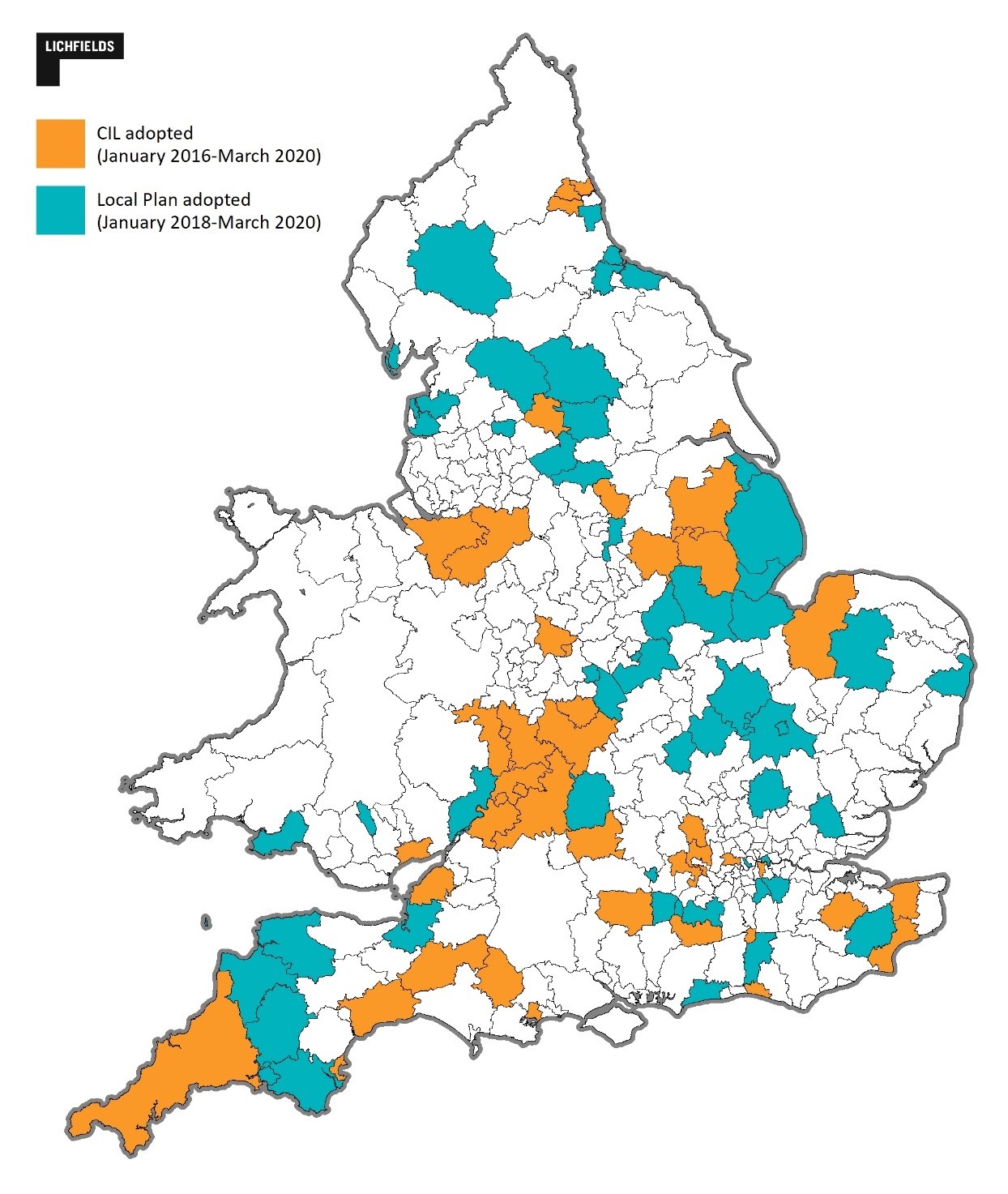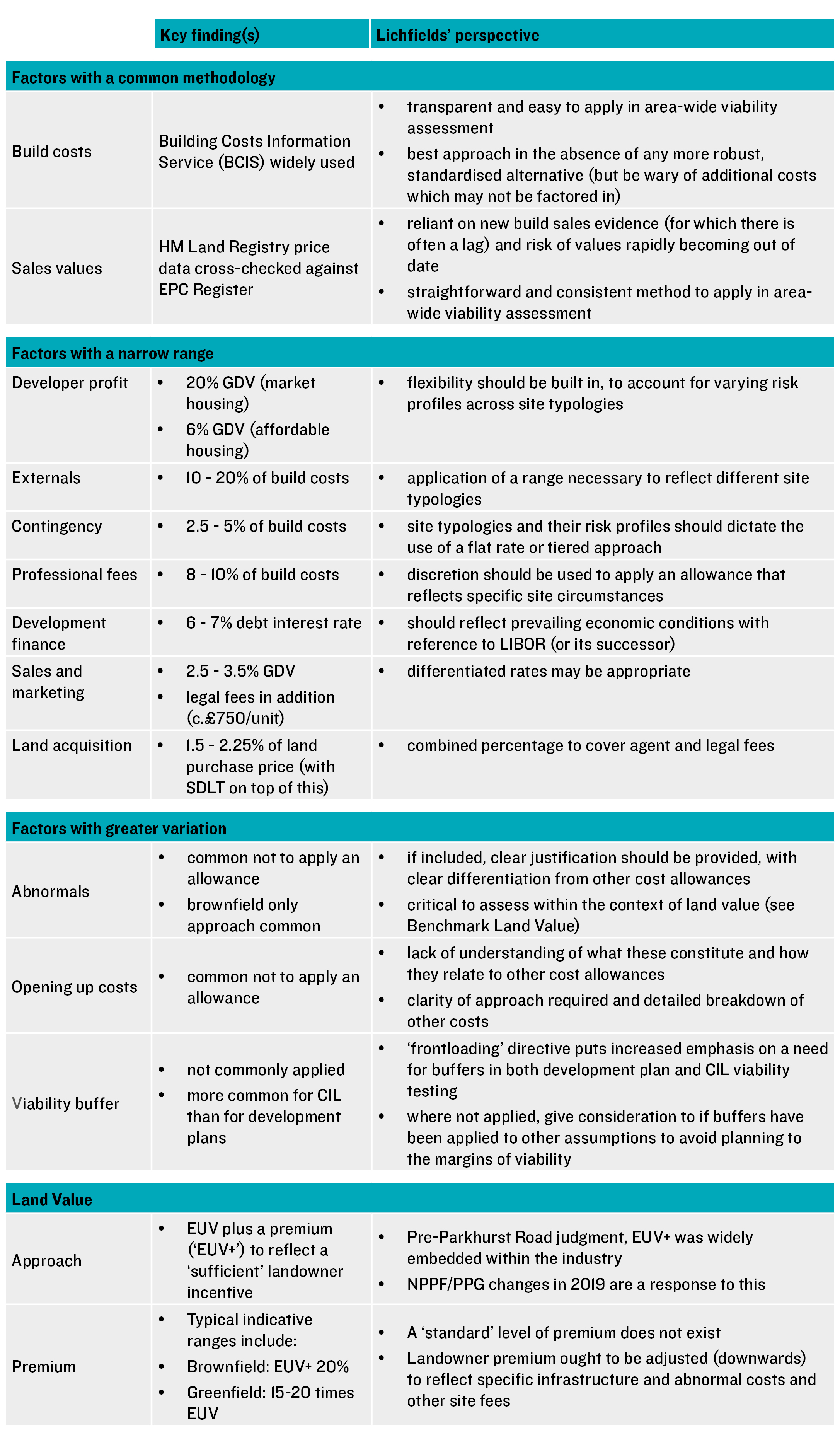On 20 July, the Government updated the National Planning Policy Framework (NPPF) to much fanfare, alongside the publication of the National Model Design Code (NMDC) and launch of an Office for Place.
These are more changes to the existing system, so more of a policy filler before the main planning reform event.
The key changes in policy are those given most property press coverage - requirements related to design and changes to the national policy considerations to be taken into account when seeking to remove permitted development rights for change of use to residential. The new national policy requirement for local plans to look 30 years ahead where large scale development forms part of the strategy is an important change too.
Apart from transitional arrangements relating to this new requirement for 30 year vision, the new and revised policies came into force immediately.
Background and Aim
The background is that in January, a year on from the publication of the ‘Building Better, Building Beautiful’ Commission’s report, ‘Living with Beauty’, the Government issued its response, setting out where it will take forward the Commission’s recommendations. Accompanying the report was a consultation on the proposed amendments to the NPPF and the content of the newly published (then draft) National Model Design Code and accompanying guidance note.
Tom Davies covered the key changes in his February blog “
Design-led - but a variety of NPPF changes are proposed”.
As Tom noted, while the press release and headlines focus on design quality and ‘Beauty’, the revisions to the NPPF cover a broader range of issues, with the Government also consulting on amendments to policies on sustainability, flood risk, and biodiversity; Article 4 Directions; protection of the historic environment; and minor changes which remove now out-of-date references within the Framework.
Almost all of the changes proposed have been taken forward. And where there are changes to the text consulted on, it is not a wholesale change in approach.
The key changes are explained below.
Improving design quality and placemaking
The Government has given centre stage to its proposals to raise the standards of design and quality of new development.
The Communities Secretary’s 20 July Written Ministerial Statement gives a summary of what the changes to the NPPF are intended to achieve in terms of design:
- “make beauty and place-making a strategic theme in the NPPF
- set out the expectation that Local Authorities produce their own design codes and guides setting out design principles which new development in their areas should reflect
- ask for new streets to be tree-lined
- improve biodiversity and access to nature through design
- put an emphasis on approving good design as well as refusing poor quality schemes”
National Model Design Code
In May 2021, 14 local planning authorities from each English region (remember them?) were selected to take part in a six month programme to test the NMDC, with a £50,000 budget each. Notwithstanding, the policy requirement to devise codes is already national policy.
According to the Government, the 14 local authorities are “generating valuable insight to help in the wider application of design coding nationally” and a further 10 pilot authorities are now sought.
The “Delivering a sufficient supply of homes” chapter now expressly refers to “places to be created” rather than to “development” and requires strategic policy-making authorities to:
“ensure that appropriate tools such as masterplans and design guides or codes are used to secure a variety of well-designed and beautiful homes”
It is these future design guides and codes that were the focal point of the Communities Secretary’s announcements on 20 July, particularly the policy that guides and codes should be based on local aspirations as established through effective community consultation. Speaking at Policy Exchange event, Robert Jenrick said:
“We are making beauty central to the planning system in a way it simply never has been, through changes to the National Planning Policy Framework and a new National Model Design Code, with communities taking the lead”.
The National Model Design Code has been published in two parts: NMDC Part 1 – The Coding Process and NMDC Part 2 – Guidance Notes.
According to the NMDC itself, its purpose is:
“to provide detailed guidance on the production of design codes, guides and policies to promote successful design. It expands on the ten characteristics of good design set out in the National Design Guide, which reflects the government’s priorities and provides a common overarching framework for design”.
The NMDC provides a comprehensive list of principles that councils should consider when formulating their own codes, with more detailed definitions and proposed parameters included within Part 2. The principles within the National Design Guide are to be taken into account too.
NPPF Design Updates
New paragraph 129 in the NPPF confirms that design codes can be prepared for entire areas or neighbourhoods, or for individual sites. It also makes clear that landowners and developers may take part in the preparation of design codes prepared by local planning authorities or neighbourhood planning groups and may also prepare codes for sites which they propose to develop. To carry weight in decision making no matter who prepares them,design codes must be developed in conversation with local communities, in order to reflect local aspirations. Where local codes are absent, the NMDC can be a material consideration.
As one might expect, Chapter 12 “Achieving well-designed places”, has been amended or augmented in several paragraphs.
As proposed at consultation stage, it states that all local authorities should prepare design guides or codes consistent with the National Design Guide or National Model Design Code – the consistency with these documents being the key element of change to revised paragraph 128 (previously paragraph 122). Previously the NPPF said “plans or supplementary planning documents should use visual tools such as design guides and codes”.
But the reference to supplementary planning documents has not disappeared, due to consultation responses which noted that the link between design guides and local planning policy was not clear enough. The NPPF confirms design codes and guides need to be produced either as part of a plan or as supplementary planning documents to carry weight in decision-making.
The emphasis on visual tools was removed after the January consultation draft stage, notwithstanding references to use of visual engagement tools in the NMDC. As before, the detail and degree of prescription within codes or guides should be tailored to the circumstances, with the NPPF now noting geographic coverage and scale of change should also be considered when devising guides and codes.
As to the degree of detail that codes should include, the NPPF continues to state that codes should “allow a suitable degree of variety”. The previous and consultation versions tagged on “where this would be justified” after “variety”, but this has been deleted and is not in the final version. This is a welcome change, particularly where guides would otherwise seek homogeneity, potentially stifling innovation and density changes.
The NPPF now gives significant weight to development that reflects guidance and policies and outstanding or innovative designs that “fit in with the overall form and layout of their surroundings”.
The latest amendments also call for development proposals that are not well-designed to be refused. This is slightly stronger wording than before, with the Framework previously stating that permission should be refused for development of “poor design” that does not reflect local design standards or codes.
Beautiful = a well-designed place
While ‘beauty’ or ‘beautiful’ has been inserted into the revised Framework and accompanying guidance, what this means locally will be informed by baseline studies and based on the ten characteristics of well designed and beautiful places as set out in the National Design Guide. These are based on the objectives for design set out in Chapter 12 of the NPPF and expanded upon within the NMDC. These bring together a range of established urban design principles such as built form (density, height and layout), movement, identity and public space which are to guide the development of local design criteria.
The Government has responded to criticisms and questions about the term beautiful:
“[…] this has been included in the Framework in response to the recommendations of the Building Better, Building Beautiful Commission. This should be read as a high-level statement of ambition rather than a policy test. The government would encourage local planning authorities, communities and developers to work together to decide what beautiful homes, buildings and places should look like in their area. This should be reflected in local plans, neighbourhood plans, design guides and codes, taking into account government guidance on design”.

Street trees
The Government proposes to take forward the Building Better, Build Beautiful Commission’s recommendations for planning policies and decisions to ensure tree-lined streets; “unless, in specific cases, there are clear, justifiable and compelling reasons why this would be inappropriate” (footnote to new paragraph 131). Furthermore, opportunities should be taken to retain trees and/or incorporate trees elsewhere in developments. There should also be measures to ensure that trees are maintained post completion; it seems that this would likely be through conditions.
Other NPPF Updates
Strategic plan-making for larger scale development to look 30 years ahead
The policy which requires strategic policies to look at least 15 years ahead has been extended to require:
“Where larger scale developments such as new settlements or significant extensions to existing villages and towns form part of the strategy for the area, policies should be set within a vision that looks further ahead (at least 30 years), to take into account the likely timescale for delivery.”
This policy is subject to a transitional arrangement and applies only to plans that had not reached Regulation 19 (pre-submission) stage at on 20 July (or equivalent stage for Spatial Development Strategies).
The Government decided against defining ‘larger-scale development’, concluding that this will depend on context, scale and setting, decided locally and tested at examination. Examples are provided within the policy. The Government is considering providing guidance on the evidence base required to support a 30 year vision.
Achieving sustainable development: Global Goals, biodiversity, flood risk and protected landscapes
Amendments have been made to paragraph 11 (a), regarding the ‘presumption in favour of sustainable development’; plan-makers will be required to “align growth and infrastructure; improve the environment; mitigate climate change (including by making effective use of land in urban areas) and adapt to its effects”. This provides a new (overdue?) reference to climate change within the presumption and perhaps aims to address to concerns raised by Tory backbenchers regarding the delivery of infrastructure provision for new housing and focusing development on brownfield sites.
The NPPF now also makes reference to the United Nation’s 17 Global Goals for Sustainable Development under paragraph 7; part of the Government’s strategy to ensure that the objectives (which the Government signed up to in 2015) are embedded in the planned activities of each Government department.
The Government’s response to the consultation hints at what might follow in terms of climate change mitigation and adaption:
“The government is considering how the planning system can further support our commitment to reaching net zero, including through the planning reform programme. Our response to the Planning for the Future White Paper, setting out next steps on these reforms, will be published in due course. It is our intention to do a fuller review of the Framework to ensure it contributes to climate change mitigation/adaptation as fully as possible”.
There have been some tweaks to the policies on biodiversity, with paragraph 180 (previously 175) saying that opportunities to improve biodiversity should be integrated into a design (rather than encouraged) particularly where it can secure measurable net gains (as before) or “enhance public access to nature where this is appropriate” (which is new).
On flood risk, draft paragraph 160 (currently paragraph 156) has been amended to clarify the sequential test should take into account all potential sources of flood risk. Further to this, the Flood Risk Vulnerability Classification is now included within the NPPF under
Annex 3, moving from guidance to policy.
The 20 July Written Ministerial Statement explains:
“We have also made a number of environment-related changes, including on flood risk and climate change. These changes are an initial response to the emergent findings of our joint review with the Department for Environment, Food and Rural Affairs (DEFRA) of policy for building in areas of flood risk. For instance, highlighting the opportunities from improvements in green infrastructure and natural flood management techniques. We are also amending guidance on flood risk to emphasise that checks done by local authorities should steer new development to areas with the lowest risk of flooding from any source”.
In light of the
Glover Review of protected landscapes, paragraph 176 (formerly 172) seeks to ensure that the scale and extent of development within the ‘settings’ of National Parks and Areas of Outstanding Natural Beauty (not only within, as previously) should be sensitively located and designed so as to avoid adverse impacts on the designated landscapes.
Article 4 directions and permitted development for residential use
The Government sought to tighten national policy on the introduction of Article 4 Directions (i.e. areas where certain permitted development rights do not apply)
where they would prevent the change of use to residential via permitted development rights
[1].
Nearly three quarters of respondents to the consultation did not agree with these proposed changes to national policy.
The Government amended the policy differently to the wording originally proposed;
confirming on 1 July that the first part of paragraph 53 now says:
“The use of Article 4 directions to remove national permitted development rights should: where they relate to change from non-residential use to residential use, be limited to situations where an Article 4 direction is necessary to avoid wholly unacceptable adverse impacts (this could include the loss of the essential core of a primary shopping area which would seriously undermine its vitality and viability, but would be very unlikely to extend to the whole of a town centre)”.
As proposed, the policy now says that all Article 4 Directions should be limited to “the smallest geographical area possible and, as before, to situations where an Article 4 direction is necessary to protect local amenity or the well-being of the area.
This pre-empts proposals for authority-wide removal of the new permitted development right for converting the new Use Class E (commercial, business and services) to C3 residential, which was proposed in December.
Unperturbed, on 21 July 2021 the Royal Borough of Kensington and Chelsea began
consultation on a consultation on a borough-wide Article 4 Direction seeking to prevent change of use from Class E to residential.
The Government intends to explore widening the extent nature of permitted development further, and the proposed amendments regarding Article 4 Direction are a nod to this future intention too.
Heritage and protections for statues
Chapter 16 of the Framework,
Conserving and enhancing the historicenvironment, has a new paragraph relating to the preservation of historic statues and related, following concerns from the Government that these were being removed “
without proper debate, consultation with the public and due process”.
New paragraph 198 states:
“In considering any applications to remove or alter a historic statue, plaque, memorial or monument (whether listed or not), local planning authorities should have regard to the importance of their retention in situ and, where appropriate, of explaining their historic and social context rather than removal”.
The policy has been tweaked from the draft version, which referred to retention, but not specifically in situ.
This policy seems intended to accompany changes to the law which were announced by the SoS in a
press release on 17 January 2021. These proposed that where a council intended to grant planning permission for works involving the removal of any statues or statutory listed objects, the Communities Secretary would be notified and would take the final decision.
More broadly, the preservation and enhancement of the historic built environment underpins much of the Government’s ‘building beautiful’ agenda; with the National Model Design Code supporting the use of character appraisals and heritage assessments to form the baseline for the development of design codes.
A few policy changes on the planning reform journey
These changes to national policy are as anticipated for some time, largely reflecting the Government’s somewhat conflicting twin focuses on both design beauty and permitted development rights, in delivering more well-designed homes.
As the Government emphasised in the consultation and the consultation outcome, this is only the beginning.
“These changes do not represent a wholesale revision of the National Planning Policy Framework, nor do they reflect proposals for wider planning reform as set out in the Planning for the Future consultation document. A fuller review of the Framework is likely to be required in due course to reflect those wider reforms, subject to decisions on how they are to be taken forward”.
National Planning Policy FrameworkNational Model Design CodeGovernment response to the National Planning Policy Framework and National Model Design Code: consultation proposals
Building Beautiful Places, Written Statement, 20 July 2021[1]Article 4(1) of the Town and Country Planning (General Permitted Development) (England) Order 2015 says:“If the Secretary of State or the local planning authority is satisfied that it is expedient that development described in any Part, Class or paragraph in Schedule 2, other than Class DA of Part 4 or Class K, KA or M of Part 17, should not be carried out unless permission is granted for it on an application, the Secretary of State or (as the case may be) the local planning authority, may make a direction under this paragraph that the permission granted by article 3 does not apply to -(a) all or any development of the Part, Class or paragraph in question in an area specified in the direction; or(b) any particular development, falling within that Part, Class or paragraph, which is specified in the direction,and the direction must specify that it is made under this paragraph”










